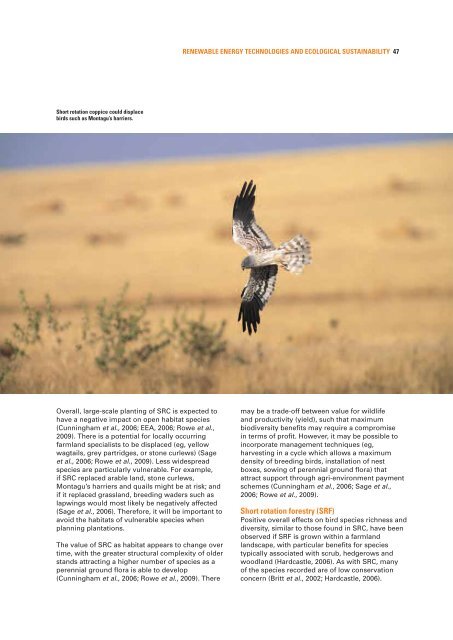Meeting Europe's renewable energy targets in harmony with - RSPB
Meeting Europe's renewable energy targets in harmony with - RSPB
Meeting Europe's renewable energy targets in harmony with - RSPB
You also want an ePaper? Increase the reach of your titles
YUMPU automatically turns print PDFs into web optimized ePapers that Google loves.
RENEWABLE ENERGY TECHNOLOGIES AND ECOLOGICAL SUSTAINABILITY 47<br />
Short rotation coppice could displace<br />
birds such as Montagu’s harriers.<br />
Overall, large-scale plant<strong>in</strong>g of SRC is expected to<br />
have a negative impact on open habitat species<br />
(Cunn<strong>in</strong>gham et al., 2006; EEA, 2006; Rowe et al.,<br />
2009). There is a potential for locally occurr<strong>in</strong>g<br />
farmland specialists to be displaced (eg, yellow<br />
wagtails, grey partridges, or stone curlews) (Sage<br />
et al., 2006; Rowe et al., 2009). Less widespread<br />
species are particularly vulnerable. For example,<br />
if SRC replaced arable land, stone curlews,<br />
Montagu’s harriers and quails might be at risk; and<br />
if it replaced grassland, breed<strong>in</strong>g waders such as<br />
lapw<strong>in</strong>gs would most likely be negatively affected<br />
(Sage et al., 2006). Therefore, it will be important to<br />
avoid the habitats of vulnerable species when<br />
plann<strong>in</strong>g plantations.<br />
The value of SRC as habitat appears to change over<br />
time, <strong>with</strong> the greater structural complexity of older<br />
stands attract<strong>in</strong>g a higher number of species as a<br />
perennial ground flora is able to develop<br />
(Cunn<strong>in</strong>gham et al., 2006; Rowe et al., 2009). There<br />
may be a trade-off between value for wildlife<br />
and productivity (yield), such that maximum<br />
biodiversity benefits may require a compromise<br />
<strong>in</strong> terms of profit. However, it may be possible to<br />
<strong>in</strong>corporate management techniques (eg,<br />
harvest<strong>in</strong>g <strong>in</strong> a cycle which allows a maximum<br />
density of breed<strong>in</strong>g birds, <strong>in</strong>stallation of nest<br />
boxes, sow<strong>in</strong>g of perennial ground flora) that<br />
attract support through agri-environment payment<br />
schemes (Cunn<strong>in</strong>gham et al., 2006; Sage et al.,<br />
2006; Rowe et al., 2009).<br />
Short rotation forestry (SRF)<br />
Positive overall effects on bird species richness and<br />
diversity, similar to those found <strong>in</strong> SRC, have been<br />
observed if SRF is grown <strong>with</strong><strong>in</strong> a farmland<br />
landscape, <strong>with</strong> particular benefits for species<br />
typically associated <strong>with</strong> scrub, hedgerows and<br />
woodland (Hardcastle, 2006). As <strong>with</strong> SRC, many<br />
of the species recorded are of low conservation<br />
concern (Britt et al., 2002; Hardcastle, 2006).
















